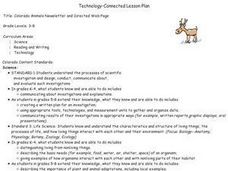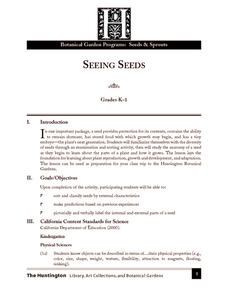Curated OER
Plant Parts
In this plant parts activity, students read for information and demonstrate comprehension. In this true and false, fill in the blank, short answer, and multiple choice activity, students answer ten questions.
Cornell University
Insect Anatomy
Young entomologists discover insect anatomy in a very detailed unit plan. Offering background information for teachers about various insects, class members explore the differences between bugs and insects—and yes, there are many...
Curated OER
How to Grow a Sunflower Plant
Learners explore botany by conducting a sunflower growth experiment. For this plant life lesson, students identify the anatomy of a sunflower plant and the essential nutrients it requires to grow. Learners utilize compost, soil, garden...
Curated OER
Peanut Anatomy
Students explore the peanut plant. In this peanut lesson, students discuss the needs and parts of regular plants. They research peanut plants to see why they are unique.
Curated OER
Flower Dissection
Students dissect three different flowers and compare and contrast them. In this flowers lesson plan, students learn about the flower anatomy and then dissect their own flowers.
Garden Earth Naturalist Club
Parts of a Flower! Flower Dissection
Sometimes the best way to learn about plants is to see the different parts of a plant yourself. Groups of learners dissect flowers to answer questions about what they observe and what they wonder about their flower.
Curated OER
Animal Diversity
Students explore biology by completing science worksheets in class. For this animal anatomy lesson, students read the book The Adventures of Marco and Polo and identify the animals mentioned in it. Students examine a real life animal and...
Curated OER
Investigating Monocots and Dicots
Students know about monocotyledons and dicotyledons. They explore the differences between the seed structure of the two by examining bean and corn seeds. They sprout seed to observe the differences in both of their growths.
Curated OER
A Botanists View
Students explore plant and seed structure. They dissect a seed and identify its parts. In addition, they explain the function and compare and contrast monocotyledon and dicotlyledons.
Curated OER
Look at Those Leaves!
Learners observe and sort tree leaves. In this plant biology activity, students observe various types of leaves and identify the characteristics of each leaf. Learners measure and sort leaves according to size and color.
Curated OER
Modeling Mendel's Pea Experiment
Students discover what Mendel uncovered in his famous pea experiments. They form explanations for the result of crossing a true-breeding round pea plant with a true-breeding wrinkled pea plant (the F1 generation) and for the results...
Curated OER
From One Seed Grow Many Seeds
First graders practice identifying plants by singing a song. In this plant life lesson, 1st graders sing the song "Parts of a Plant" which is based on the anatomy of sunflowers. Students discover agriculture techniques while viewing a...
Curated OER
Understanding Evolution: Homology and Analogy
In this understanding evolution worksheet, 9th graders define homology and analogy. Students compare and contrast similar structures in several given species.
Curated OER
Illnois River and Lake Mussel Habitat Diorama Activity
Students identify the environmental elements of river and lake mussels. They compare the elements to the time before settlement and during industrialization. They also participate in a field trip to a mussel exhibit.
Curated OER
Which Way to Roots Grow?
Second graders explore roots and how they grow. They observe as seeds planted in various directions grow and record their observations. Students discuss the direction in which the roots are growing.
Curated OER
Physiological Adaptations
Young scholars investigate the concepts of genetics and how it is tied to the variations found within different species and how it is tied to adaptations. They review the theory of evolution and factors found to help create variation....
Curated OER
Top 10 Summer Science Lesson Plans
Make this summer an exciting learning experience for your students with these engaging science activities!
Curated OER
Colorado Animals Newsletter and Directed Web Page
Students select a Colorado animal, develop a Directed Web page, and research their animal. Each member of the group combine their research and develop a Newsletter.
Curated OER
Investigation Xylem
Students investigate how water travels up the stem of vascular plants by using food coloring to stain the xylem of a number of different plants. They know the function of leaves, stems, and root at the end of the experiment.
Curated OER
"The Good, The Bad, and The Smelly."
Students explore insects' use of pheromones and beneficial insects versus insect pests.
Curated OER
A Cell Is Like A City
Students create analogies that help them remember the cell parts as well as their respective functions.
Curated OER
Seeing Seeds
Learners identify different types of seeds and label the outside and inside of a seed. Students create their own model of a bean seed.
Curated OER
Tulips: Predicting the Arrival of Spring
Students use the blooming of tulips as a tool to measure spring's journey north. They predict when tulips bloom at 13 selected Journey North gardens in various geographic regions.
























